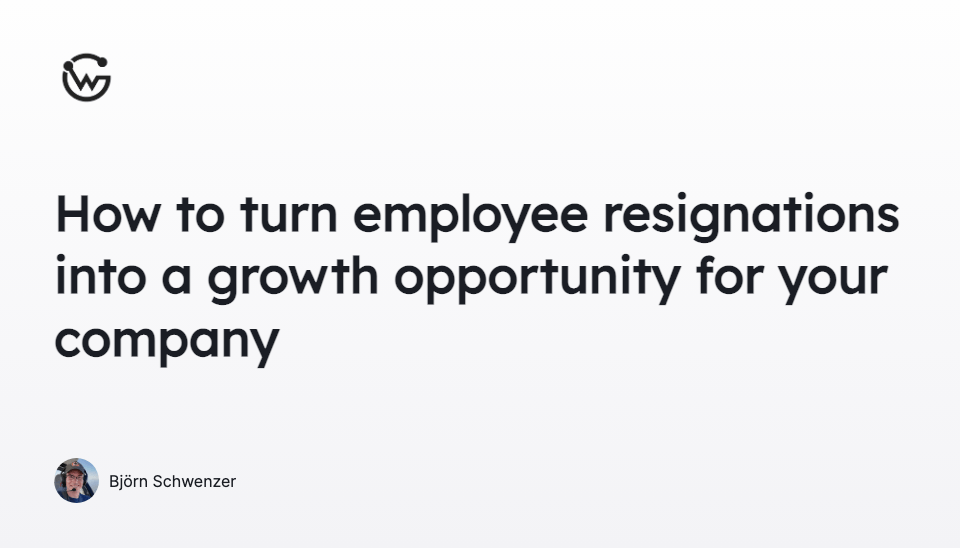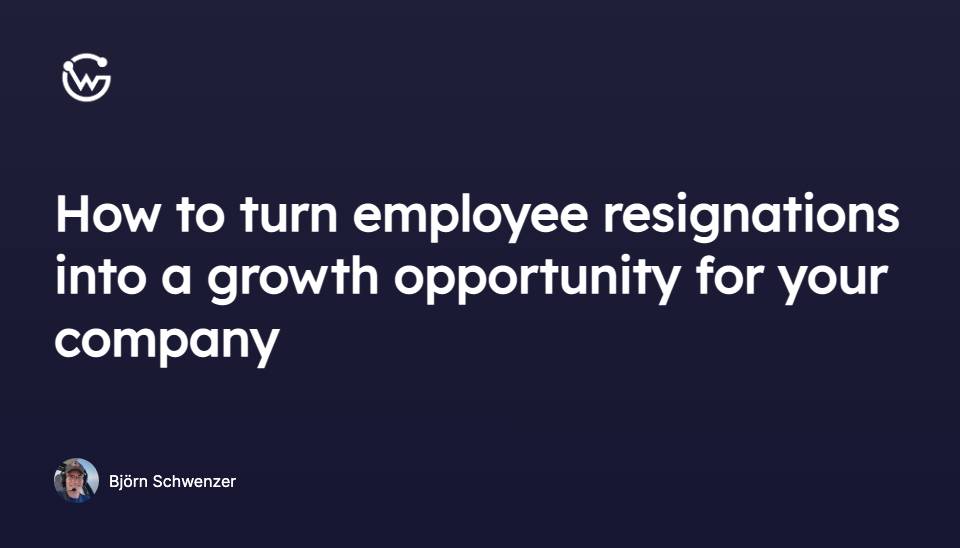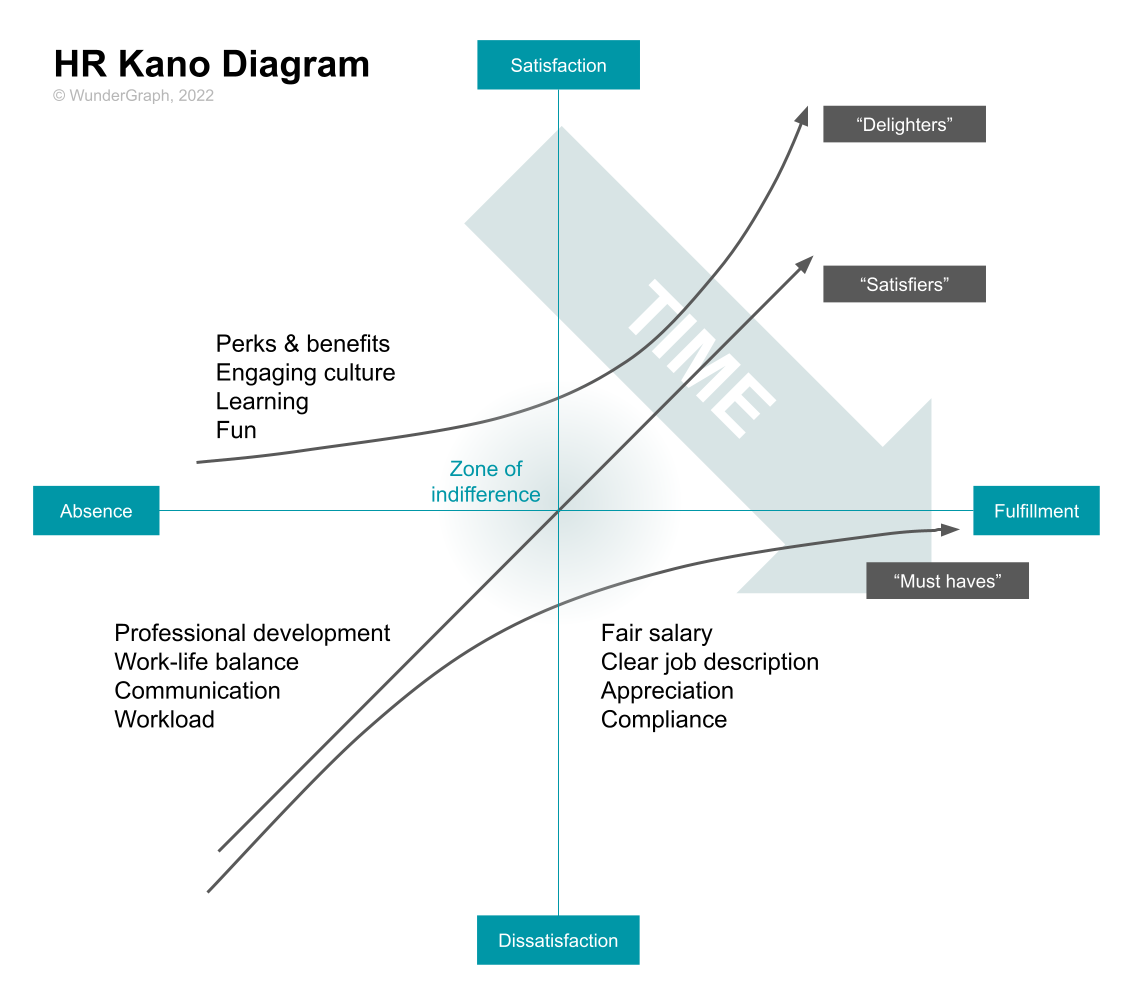How to turn employee resignations into a growth opportunity for your company


Björn Schwenzer
Introducing WunderGraph Hub: Rethinking How Teams Build APIs
WunderGraph Hub is our new collaborative platform for designing, evolving, and shipping APIs together. It’s a design-first workspace that brings schema design, mocks, and workflows into one place.
When team members decide to move on, it’s actually a great opportunity to learn and improve – as long as you’re willing to be honest with yourself and accept uncomfortable truths.
Probably the greatest thing about running your own startup is that you get to call the shots: vacation policy, remote work, agile management, work environment, communication, education, remuneration, values etc. – finally, there is nobody telling you how it needs to be done. You can build the company that comes the closest to your ideal of the perfect workplace, and which hopefully resonates with a lot of people out there who would enjoy signing up for the ride.
For me, it was - besides the technical challenge and my overall startupy nature - the main reason to leave a safe job and good salary behind and co-found WunderGraph. I’m a company builder, and with more than 20 years of experience, I have a strong idea of how our fledgling enterprise should be shaped.
Besides many exciting things that you really enjoy, there will also be less favorable events, like seeing good people go. This is a natural process - after all, it’s a business relationship, not a marriage, and also running a company may call for tough decisions sometimes to keep the boat afloat. However, during my career I have seen many leaders and executives fret about people leaving, for various reasons. In this article, I will try to explain why these events actually are an opportunity to build a better company, improve team cohesion and review your people management principles.
Besides being a company builder, I’m also a true believer in agile and UX. I had the pleasure of introducing agile management and methodology in many companies and teams over the years, and what helped me tremendously is my UX background. One guiding principle of both agile and UX is to consider feedback as a gift, and as such to always welcome and embrace it.
The biggest challenge here is to shove your ego aside if the feedback does not seem to value what you have said, done or intended. It’s really hard to listen and understand, and then reflect on what you could have done better. It takes a lot of training and self-restraint to swallow your snippy retort and try to work out the relevant factors of the feedback you’re receiving, but I promise you that it’s well worth it and separates good from great leaders.
With that concept in mind, let’s look at the situation of a valued team member deciding to leave your company.
First and foremost, you need to remember that this is part of professional life, and it should be treated as such. Which means: there is no room for hurt feelings or even anger. In many cases, managers feel that employees resigning at the “wrong moment”, for example after having received training, a corporate car, promotion or some treat, and thus being ungrateful or unappreciative of their opportunities with your company. The problem is that there is no “right moment” – losing a highly skilled and talented employee always sucks, and people are entitled to make their own decisions for whatever reason, and they naturally see the world differently than you. That’s why rule number one is:
Don’t take it personal
What your company must have in place is a proper process for handling leavers. It’s no excuse if your company is small or that your HR team is run externally - the point is that there are clear steps to follow which give guidance to both you and the employee. It doesn’t need to be tool-based or overly complex, but it’s a matter of professionalism to have these things prepared, even if it’s just a small to do / check list.
Have a leaver process in place
The leaver process should include everything that needs to be done until the employee leaves your payroll, so it doesn’t stop with garden leave or the last day on the job. As part of the process, you can also attempt to win back the employee, but I’ll touch on that later.
I cannot emphasize enough how important this process is, as it will determine the relationship between you and the leaver from this moment on. If done right and professionally, it can be very beneficial for both parties going forward as you always meet twice in life (at least). This is also why it’s pointless and even counterproductive to bind employees with non-compete or no-pouch clauses in their contracts. For one, it’s hard to enforce, and it usually just creates aggravation, bad PR and wealthy lawyers. You should ask yourself if it’s really worth the trouble.
The most important step of the process is to gather information on what led up to an employee’s resignation so you can learn from it and take action.
Learn as much as you can, and don't let your personal pride get in the way
To be frank, it is likely that you screwed up somewhere in the past and are not entirely innocent of that person’s leaving. Now is the time to find out where and how, so you and your organization can learn from it.
It is critical that this is about your learnings, not about the employee’s (if you are a really good manager and coach, you will also help the employee reflect on his/her tenure, of course). What you should strive to understand is:
- What were the drivers relevant for leaving, and
- What was the trigger that made the employee hand in her/his resignation letter
The difference between drivers and triggers is that the drivers are factors people usually tolerate, but which accumulate over time, whereas triggers are singular events leading to executing the plan to leave. Think of it as a bucket that steadily fills with water (drivers), and the fuller it gets, the less you need to make it spill over (triggers). Triggers have a profound effect on this bucket - sometimes it’s a gush of water (a denied promotion or salary raise, a row with the line manager), sometimes just the final drop that people won’t take anymore. In both cases: if the bucket is full, the decision is made. Depending on the trigger, more time may pass, e.g. when people are waiting for the right job opportunity, but there hardly is a way back.
The drivers to resign accumulate from day one, starting with how you treat new hires.
Whereas triggers are sometimes impossible to avoid (job offer, life-changing event), you can do a great deal to get drivers under control - if you ask the right questions.
The best way to collect this information is during the exit interview. You may consider not doing it yourself, but handing this over to HR or a different manager in your organization to avoid any bias you might introduce should you have been the line manager or otherwise responsible for this particular employee. It may also help the leaver speak freely and not hold back.
In any case, if you should do the interview yourself, try to bring someone else with you as a neutral observer - you will be surprised how your perceptions may differ if you’re involved personally.
Ensure that the information collection is not biased by your personal views.
I strongly recommend introducing some metrics to the feedback by having the leaver rate his experience (especially the drivers) on a scale from 1 to 5 whenever possible / reasonable. For example, if the leaver states that she was unhappy with the feedback that she got, ask her to rate it on that scale. This also has the positive effect that the leaver will have to think about that statement’s quality.
Metrics are your friend.
It’s critical that this interview is about asking questions and listening, not criticizing or commenting. It’s all about the employee and what you can learn, which may include questions like: “What would have been your ideal scenario?” or “What was your expectation?”. Try to work out the drivers and also find out about the trigger for the decision.
This is also the reason why it usually doesn’t work to “win someone back” – if the reasons for leaving are not addressed swiftly and with substance (i.e. no quick fixes that won’t cure the actual problem), all you have left to offer is (smart) money, perks or promises. Even if this works, it’s likely just prolonging the inevitable by a few months.
Even if you can’t win back a leaver, you now have the data to make a difference in the future and for many others still with you, but affected by the same drivers. You can analyze each trigger, maybe together with your leadership team, your line manager or an HR business partner. In almost all cases, the chain of events that lead to someone resigning started a long time ago on a level where the drivers were mainly nuisances, in itself tolerable and not dangerous.
What has proven valuable in the past is to create an "HR Kano Diagram" that lists the drivers along the Kano priorities and clearly shows how exciters or satisfiers can move into the area of basic needs you must cover. For example, payment can be ok in the beginning, but if it doesn’t grow in line with the employee’s skill level and responsibilities, it will quickly become a basic need that will spark great dissatisfaction if not fulfilled.

Especially with juniors, the learning curve will be steep in the first one or two years, and their value may well exceed your average pay increases that a CFO would like to see (“A raise of more than 5%? Excel says no.”). The effect is that you set the timer on a bomb that might hit you in the most inconvenient moment, i.e. when people have grown into important owners of your operations and are no longer easy to replace.
It may seem simple to play down losing a single good employee as a singular event, but in fact it should be a wake-up call. A leaver sends you a message on what you can do better in order to retain good talent for a reasonable amount of time. It’s up to you to listen, understand and act on it.
You grow your network
Staying in touch through LinkedIn or other channels allows you reach out anytime, may it be to make an intro, request some expertise or pitch your products
You gain potential new clients (or promoters) through the leaving employee
Today’s employee is tomorrow’s customer / business partner. Treat them well, and you’ll end up with many contacts out there who will think of your solutions first if the need arises
People may return with better skills
Like a soccer player being lent to a different club for a time to return as a more mature part of the team after one or two seasons, allowing people to hone their skills in a different environment can work wonders. It’s not unheard of that somebody, especially homegrown talent, returns to their previous company with substantial value to add.
You get the chance to retain existing talent
Find out what the drivers are, and work with your leadership team to eliminate them one by one. Use the HR Kano Diagram, or the 5-Whys-Method, or a fishbone diagram - whatever works for you as long as you dig deep and get some actionable insights. This may help you to win back employees who already had their fair share of drivers to think about, before a trigger event.
You get the chance to become a more attractive employer
If done right, you can leverage actions you implemented to highlight your advantages as an employer. Did you just introduce a specific support program for young managers or a new feedback system? Tell the world and get better / more job applications in return!
You get the chance to set right misconceptions in your company (e.g. wage tables)
Especially if you’re not the decision maker, you need proof that existing concepts and models might need an overhaul.
You get the chance to grow and be a better leader
Challenging situations shape character. Find out what you could’ve done differently or better by taking the leaver’s feedback to heart, without your personal pride standing in the way. It may be tough and you may not agree with everything, but it’s enormously beneficial to be aware. If you want to grow, this could make an excellent starting point. Don’t be afraid to discuss this with your manager, your peers or some unrelated party such as HR.
You can also make good on communication by being transparent and open about what’s going on. Many companies treat a leaver like a calamity that they would rather not talk about, and forget as fast as possible. The intent behind this is to prevent potentially negative effects on teams and the company by not making a fuss and moving on quickly. The problem is: it just doesn’t work, and what’s worse, it has a contrarian effect. The more a company tries to pretend everything’s just another day at the office, the more employees will perceive it as a SNAFU, fueling existing drivers or setting triggers (“if she leaves, the ship is sinking, and I need to get off board quickly”).
- Communicate quickly in the relevant circles. Be faster than potential rumors or you’ll lose the initiative.
- Decide together with the leaver who talks to whom and what the storyline is. Be reasonably honest.
- Express your regret and appreciation, preferably “in person” (i.e. not on a Zoom call)
- If applicable, feel free to explain that the event gave you some food for thought and you will be back with some ideas. You don’t have to present anything immediately, and if you did it would not seem very thought through.
- Look forward and tell your team how you will proceed, even though there may be no precise plans yet. People are grown-ups, they can take some uncertainty as long as they know you’re working on it in earnest.
As you can see, it’s not that hard to turn the unfortunate event of losing a valued team member into an advantage for you, your team and your organization. It can create opportunities for growth and improvement, and it can also be a chance for the company to reflect on its policies and practices and make changes to better support and retain its key employees.
The catch is that you have to be able to effect change in your organization if needed, and of course that you need to be able to self-reflect, accept feedback, and drive your own personal change.
WunderGraph Cloud Early Access
Björn Schwenzer
COO & Co-Founder at WunderGraph
Björn Schwenzer is the COO and co-founder of WunderGraph, overseeing finance, legal, HR, information security, and day-to-day operations. He works closely with the team to ensure smooth operations, compliance, and execution of company strategy, drawing on extensive experience from previous C-level roles.

